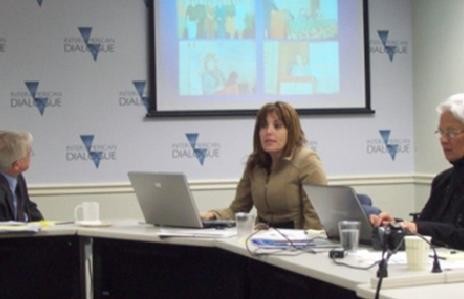
National Conference on Teacher Policy in Costa Rica
Workshop that seeks to promote debate on teacher policy and showcase innovative policies.
Given the difficult situation that the region faces, many Central Americans are migrating by any means possible. While the number of people leaving the region has been well documented, what is less known is how many end up returning home, either voluntarily or involuntarily. In 2014, for example, an estimated 130,000 Central Americans crossed the US border,[1] while 250,000 Central Americans were deported from the US and Mexico[2] and as many as 100,000 may have returned voluntarily.[3] Though large numbers of migrants are leaving and others returning, public policies for coping with this movement are limited, and many returning migrants find themselves in the position of trying to rebuild their lives with little assistance and already exhausted resources.
Trends in Central American Migration
Emigration and deportations represent major challenges for Central American countries, particularly El Salvador, Guatemala, and Honduras, which have the largest volume of people emigrating. Over three million Central Americans live in the United States today, as the table below shows.
There are several key issues to highlight here. First, those who come to the United States largely do so by crossing the border. Second, the number of people apprehended and deported has increased substantially in recent years.
Trends in Return Migration
Undocumented migrants face a difficult and dangerous journey with multiple points of apprehension and deportation. First, they may be apprehended while trying to cross Mexico. According to figures from the Guatemalan government, nearly 80,000 Central Americans were deported from Mexico in the first six months of 2015, compared to roughly 50,000 in the first six months of 2014. Second, many Central American migrants are apprehended in the US, either while trying to cross the border or while they are living and working in the interior of the country.[4] In FY 2013, 73,000 Guatemalans, 64,000 Hondurans and 51,000 Salvadorans were apprehended by US immigration officials. Many of these apprehensions will eventually result in deportations. In FY 2013, for example, the United States deported 108,000 Central Americans.
While deportations are occurring on a massive scale, not all return migration is involuntary. Some migrants may reach Mexico or the United States and realize that they need or want to return home for a variety of reasons. Other migrants may migrate to the United States with the express intention of working for several years and then returning home to their country. Surveys by the Inter-American Dialogue suggest that around half of migrants intend to return home at some point, and 2-5% of migrants plan to return that same year.
These figures point to the magnitude of people returning to Central America. To put things in perspective, deportations alone are equivalent to at least 50% of the annual increase in the labor force in Central America. While every year nearly 500,000 Central Americans join the Central American labor force, at least half of that number attempts to enter the US and is turned back.
Policy Responses
Though large numbers of migrants are returning – both by choice and by force — public policies for coping with this influx are limited, and only one in twenty migrants who are returning involuntarily from the US may receive some form of reintegration services. Existing programs for return and reintegration tend to be small, disparate, and relatively recent, as the table below shows.
Specific Challenges
“The entire topic of return migration is a challenge,” a Central American government official mentioned in an interview with the Inter-American Dialogue, noting that, despite their best efforts, attention to return migrants is simply “insufficient.” Many programs noted that a lack of resources has been a major challenge. Both government and NGO initiatives have struggled to find adequate funding, and many operate on a very limited scale. Other challenges include coordination among various government agencies, including migration, labor, health, and child services. Finally, it can be a challenge to reach returning migrants to offer support or assistance once they pass through migration checkpoints and disperse to their home communities.
In light of this, migrants must try to rebuild their lives in their home country with limited resources and limited assistance. The specific challenges they face are as diverse as they themselves are. Migrants returned from the border, for example, often return to the same difficult situations that caused them to migrate in the first place. However, they may also face financial issues and debt related to the costs of the unsuccessful migration attempt.[5] Migrants who have been in the US longer may face a different set of challenges related to labor force or educational reintegration. In addition, return migrants may face stigma or discrimination related to the stereotype that deportation is linked to criminal behavior. However, according to a Salvadoran government official, “It’s important to recognize that a huge number of these people have no criminal background of any kind.”
This is part of a series of posts on Central America by the Migration, Remittances and Development Program at the Inter-American Dialogue. An upcoming book by Manuel Orozco and Julia Yansura, Centroamérica en la Mira: La migración en su relación con el desarrollo y oportunidades para el cambio (Editorial Teseo, 2015) offers more in-depth analysis of these issues.
[1] Probably only half of those who attempt to enter the United States.
[2] This is a rough estimate based on 108,000 Central Americans who were deported from the United States in FY 2013 and roughly 150,000 who were deported from Mexico in 2014. These figures may contain some overlap if a migrant was deported multiple times.
[3] A 2009 survey found that 2% of migrants intend to return home that same year, and a 2015 survey found that 5% intend to return home this year.
[4] Data suggests that 85-90% of DHS removals occur at the border, compared to 10% from the interior of the United States. For more information, see Rosenblum and McCabe, “Deportation and Discretion: Reviewing the Record and Options for Change,” MPI, 2014.
[5] See, for example, Rodrigo Soberanes, “Los migrantes que llevan una bomba de tiempo por equipaje,” Ladobe, 27 July 2015. Available at: https://goo.gl/e2Tpm7
Workshop that seeks to promote debate on teacher policy and showcase innovative policies.
PREAL reviews broad spectrum of its activities and discusses priorities for improving education policy in the coming year.
Progress of Latin American countries and the Caribbean towards the six Education for All goals.
